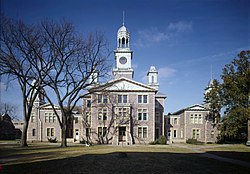History
Founding and Early Years (1883–1913)
The museum was founded in 1883 by the Board of Regents as the University Museum at the University of Dakota. It began as a single display case of natural science specimens housed in University Hall (now Old Main). In 1893, a fire destroyed the building and much of the early collection; only materials on exhibit at the World's Fair and some rocks and minerals survived. [3] The South Dakota Geological Survey operated the museum from 1902 until 1927.
W. H. Over Era (1913–1948)
In 1913, William Henry Over was hired as Assistant Curator. At the time, many of the Survey's collected specimens remained in shipping boxes, and Over was tasked with formally cataloging and exhibiting them for public viewing. He became Curator in 1927 and held the position until his retirement in 1948, after 35 years of service. In 1949, the Board of Regents renamed the museum in his honor.
Transition and New Building (1960s–1996)
The Friends of the W. H. Over Museum, a non-profit support organization, was formed in the late 1960s, with Dorothy Neuhaus as an instrumental figure. During this period, the museum was housed in the university's former Carnegie Library building.
In 1984, the museum's collections were moved into storage for four years after the university allocated the Carnegie building to the Shrine to Music Museum (now the National Music Museum). [4] The "Friends of the W. H. Over Museum" organization, led by advocates like Neuhaus, spearheaded a major fundraising campaign for a new, dedicated facility. Neuhaus and other supporters famously marched in the Dakota Day Parade with shovels to raise awareness for the new building project. The current 29,200-square-foot building was completed and opened in 1988. [5]
Post-State Funding (1996–Present)
In 1996, the State of South Dakota withdrew all financial support for the museum. The "Friends of the W. H. Over Museum" assumed full responsibility for its operations and funding. [6] Dorothy Neuhaus helped lead the museum through this critical transition, serving as Board President (1996–1998), Acting Director (1996–2000), and Director (2001–2005). During her tenure as director, she oversaw the opening of the Spirit Mound Learning Center and the museum's programming for the Lewis and Clark Bicentennial Celebration.
Notable People
William Henry Over
William Henry Over (1866–1956) was a self-educated naturalist with an eighth-grade education who homesteaded in South Dakota before joining the museum in 1913. [7] He conducted extensive investigations of fossil deposits and archeological sites across the state, authoring numerous books, including Birds of South Dakota (1921), Amphibians and Reptiles of South Dakota (1923), and Flora of South Dakota (1932).
He is credited with discovering several new fossil species that were named in his honor, including a snail (Pisidium overi), a clam (Anodonta dakota), and a fossil crab (Dakotacancer overana). In 1936, the University of South Dakota awarded Over an honorary Doctor of Science degree in recognition of his scholarly contributions. [8] Over is also noted for his 1920 excavation of the Ludlow Cave, a significant archaeological site in South Dakota. [2] His last publication was the Life History of Sitting Bull, in 1950. [8]
Dorothy Neuhaus
Dorothy Neuhaus (c. 1924–2025) was a key figure in the museum's modern history. She was instrumental in founding the "Friends of the W. H. Over Museum" organization in the late 1960s and established its gift shop. Neuhaus was a "driving force" in the campaign to fund and build the new museum facility in the 1980s after it lost its space in the Carnegie Library. Following the loss of state funding in 1996, she served as Board President (1996–1998), Acting Director (1996–2000), and ultimately Museum Director (2001–2005). [9] For her positive relationship with Indigenous people, she was named a "Tribal Elder."
Operations
The museum is governed by the Friends of the W. H. Over Museum, a non-profit board of directors. As of 2023–2024, the board's officers include Lynn Muller (President), David Moen (First Vice President), Calvin Brink (Second Vice President), William Ranney (Treasurer), and Maxine Johnson (Secretary). [18] Board President Dr. Lynn Muller also serves as the curator of the museum's Photo Center and led the 2019 restoration of an 1888 view camera found in the collection. [16]
The museum's mission is to "collect, preserve, document, exhibit, research, study and interpret objects relating to natural and cultural history, primarily of South Dakota." [1] Admission is free. [19]
The museum actively collaborates with the University of South Dakota. Students in classes such as "Museum Techniques" have curated exhibits on topics like the Dust Bowl, World War I, and assisted in documenting the museum's Egyptian mummy. [20] The museum also functions as a community hub, hosting annual public events such as the "Chilli Blues" fundraiser, an Annual Christmas Festival, and "Nature Play" activities for Vermillion Earth Days. [21]
The museum includes a Discovery Room with hands-on activities for children and a gift shop. The gift shop sells a variety of items, including handcrafted jewelry, quilts, and supplies from local and Native American artisans. The museum also co-publishes a joint newsletter with the Clay County Historical Society and the Clay County Historic Preservation Commission. [18]
This page is based on this
Wikipedia article Text is available under the
CC BY-SA 4.0 license; additional terms may apply.
Images, videos and audio are available under their respective licenses.



